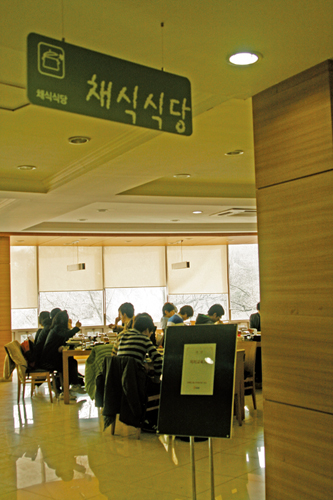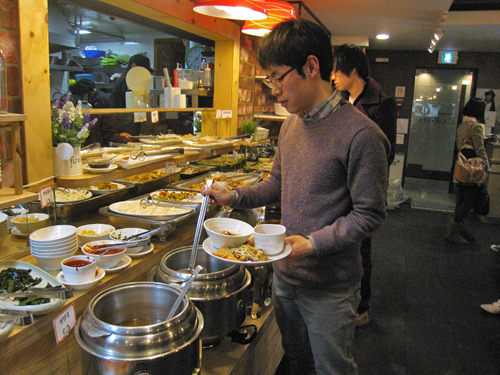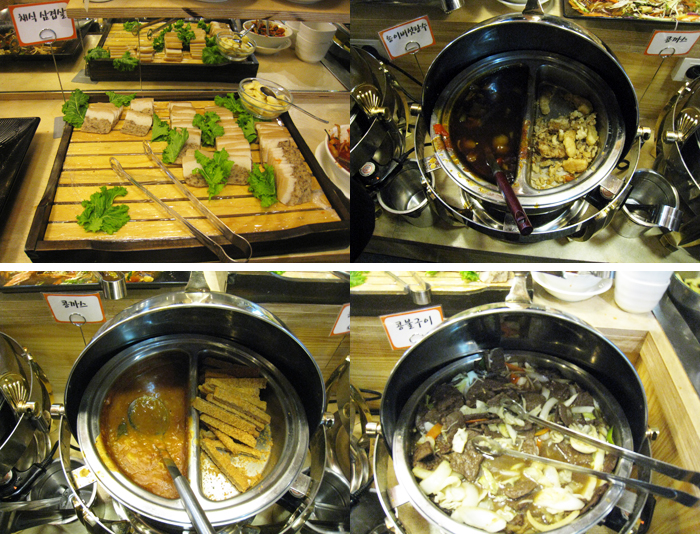The Post visited two vegetarian diet buffets. Here is the story of two green restaurants.
 | ||
Before these restaurants opened, it was often tricky to find the right places to eat on campus. It was much trickier when people had various dietary requirements, or were vegetarians.
As Buddhist monks tend to avoid eating meat products, they packed their lunches and brought them to school. In other areas with college campuses like Shinchon and Daehakro, it was not so hard for students to find a number of vegetarian restaurants.
As monks at Dongguk University were having a difficult time sticking to their principles, they continuously wanted and pleaded to have a vegetarian restaurant open on campus. In response to the demand, “OurHome” opened on the 3rd floor of the Sangrokwon (Student Restaurant).
There were no short supply of customers and the atmosphere has been explosive. As the dining room was a small size, this made many customers wait several minutes to place their orders. This semester, the green restaurant welcomes customers with a larger size eating area. The price for meals is 7,000 won.
Lee Sang-min, a manager of the restaurant, said “Mostly, Buddhist monks and vegetarians visited us. “OurHome” is also available to all students, however. You can have a great time with green foods in our place.”
“OurHome” serves brown rice, tofu, mushroom and ssam - most foods are tasty and nutritious. Essential proteins that vegetables lack are also balanced with some eggs in this restaurant. “Garobee” has a reputation as one of the finest vegetarian restaurants in Seoul. The Post visited this vegetarian diet buffet. This place was especially suitable for vegans, people who never eat meat or any animal products such as milk, butter, or cheese.
 | ||
| ▲ The post reporter is trying some vegetarian meal for the first time. | ||
The place tries hard to provide healthy food without using GMO (Genetically Modified Organism) products or animal oil. Instead, they use fresh ingredients and vegetable oil such as olive or sunflower oil. As they care for visitors’ health, they also use seagull4 water purifiers, which help to remove chlorine from tap water, to serve water and wash vegetables.
“People from all age groups visit our restaurant every day with various appetites. The reasons vary from minding beauty to one’s religious beliefs,” said Park Hye-soo.
Since the restaurant is located in the food alley in Yeoksam-dong, it became an easily approachable place for young college students and foreigners. Some of the visitors simply come to lose weight or enjoy the vegetarian meals, while others come for serious health problems such as high blood pressure, diabetes or atopic allergies.
Moreover, people who pay attention to environmental problems like world starvation or animal protection often visit the restaurant to deal with these matters. However, visitors do not necessarily have to be vegetarians because the restaurant has some dishes taste just like meat although there is no meat in it. The manager Park said, “We use glutelins from beans to make the food chewy like real meat.”
Here is the menu - pictures will be attached. Those are called ‘vegetarian samgyupsal’, ‘gill fungus Chinese sweet and sour pork’, ‘bean cutlet’ and ‘roasted bean.’ Indeed, these are the most popular ones among non-vegetarians for their unique recipes and taste.
 | ||
| ▲ 1. Vegetarian samgyupsal: made of bean and mushroom, which looks surprisingly similar to the original pork ‘samgyupsal’ but tastes chewier and a little bland. 2. Gill fungus Chinese sweet and sour pork: made of gill fungus, which looks the same as ‘Chinese sweet and sour pork’ but has a less fatty taste. 3. Bean cutlet: imitation of ‘pork cutlet’ made of bean. It tastes stiffer than the original. 4. Roasted bean: the most meat-like vegetarian dish, made of bean. It tastes the same as meat. / Photograph : Lee Jong-seok, Jeon You-na | ||
Just like its name, ‘gill fungus Chinese sweet and sour pork’ is made of gill fungus. It tastes similar to the original Chinese sweet and sour pork because of its sauce but it has less fatty flavor than the original. Interestingly, the ingredients used to make its sauce only include vegetables.
Next, ‘bean cutlet’ is the imitation vegetarian meal of ‘pork cutlet’, which is made of pork. However, even though ‘bean cutlet’ has no meat in it, it looks the same as ‘pork cutlet’ but it has less softness.
Lastly, ‘roasted bean’ was the most meat-like food among these four and it was made of bean. It has the exact same taste and texture as meat so it was enough to forget the fact that it was not real meat. It is also widely known as a diet food among the celebrities because it does not have bean’s flavor at all and has good nutrition in it.
Targeting young generations using IT devices
Especially young generations are enthusiastic about green foods. With using IT devices, they find out the nearest vegetable restaurants from their current location. Vegetable Restaurant Application enables them to do this. With the application, users can find out the location of the restaurant, menu, prices, and reviews of other users. Young vegetarians enjoy visiting the list of restaurants the application shows. According to the application, more than 100 vegetarian restaurants are in Seoul and more than 500 restaurants over the nation.
Various reasons for becoming vegetarians
The reasons for becoming vegetarians are diverse. Some students who live far from their hometowns usually lack nutrition. They visit vegetable restaurants for the purpose of eating fresh green foods. Yang Yu-seok, a student of Seoul National University said, “I live near the school by myself so I am often tempted to go to fast food franchises. I regularly visit my school vegetarian restaurant to maintain a well-balanced diet.” Another reason why people visit vegetable restaurants is to treat minor diseases. People who suffer from constipation or skin diseases are advised to eat many vegetables and vitamins. They cannot stick to regular dietary requirements in general restaurants so they often visit vegetarian restaurants to get their needed vitamins.One customer in the “OurHome” restaurant said, “I was really far from being a vegetarian. But after I got some boils on my body, I began to come here to get some fresh food.”
Effort to fix the price problem
While vegetarian food has these advantages for one’s health, there are also some concerns for its high price. The average school meal costs about 3,000 won, but vegetarian food costs between 7,000 and 8,000 won. Since many college students feel so much pressure for their life expenses, it is not easy for them to afford vegetarian meals. To fix this pricing problem, the manager of vegetable restaurant Park Hye-soo said, “We are working on the quality of the food and trying our best to improve customer’s satisfaction beyond the price.” Seoul National University is also putting their effort to develop diverse vegetarian menus and some set menus for cheaper and reasonable prices of 3,000 won.
Tips for vegetarian wannabes
Here are some tips for those who are in the early stages of becoming vegetarians or those who want to try some vegetarian food selections. ‘Brown rice’ and ‘Janchi guksu’ are the simplest dishes that can be cooked at home. For the ‘brown rice,’ all you need to do is cook brown rice with mixed grain and the perfect nutrition meal is completed. Brown rice has an abundance of vitamins which can fix collapsed nutrition balances caused by the lack of eating meat. To make ‘Janchi guksu,’ all you need to do is to simmer the vegetable instead of anchovies to prepare stock and put noodles, dried laver and kimchi in the stock. Also, whenever you miss meat, grind beans with vegetables and steam or knead it with glutelins. Then you can have the same taste and texture as real meat with less fat and more nutrition. For further information about various vegetarian foods, visit ‘www.vege.com’ and you will be able to find the suitable choices for your own taste.

